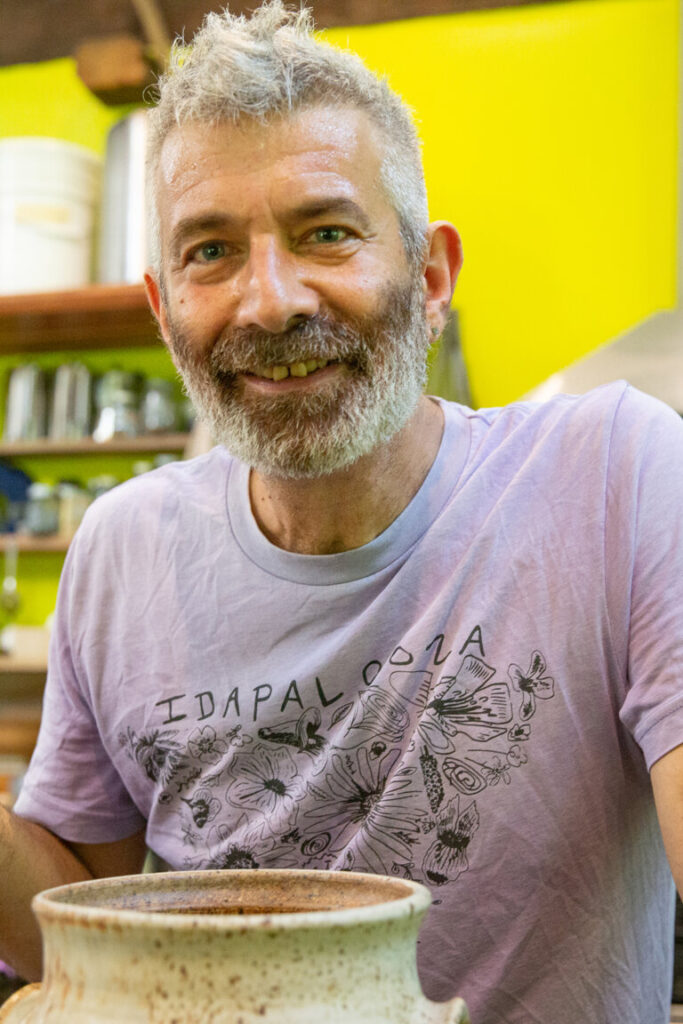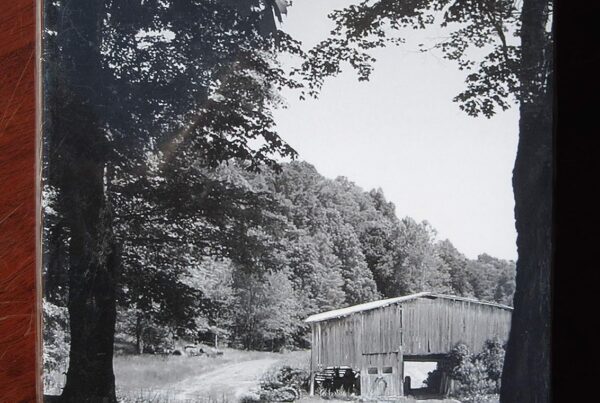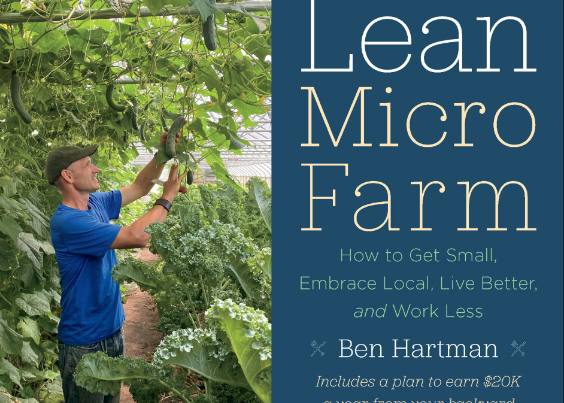
Book Review: Sandor Katz’s Fermentation Journeys: Recipes, techniques and traditions from around the world, by Sandor Ellix Katz.
Chelsea Green, 2021, 252 pages, hardcover, $35, color photos throughout.
This brand new book will make an amazing gift for your friend who is very enthused about all kinds of fermented foods and drinks. Sandor Katz is the world’s most well-known and respected advocate of all things fermented, and the author of four previous books on the subject. This book includes directions and recipes for over 60 fermented foods from across the world. Sandor travelled the globe learning, teaching and tasting every day. And this time, Sandor had a camera, and the pictures are fascinating. This is his first book in almost ten years, so you can be sure there are many foods you haven’t met before.
To his credit, Sandor shows deep respect for the cultures (human, fungal and bacterial) that he encounters, and invites us to do so too. He describes the traditional techniques as well as the customs and ceremonies attached to the ferments. Here are some well-known fermented foods, such as sauerkraut (in a chocolate cake), tempeh, cheeses, and breads, and also much less well-known ones like pickled tea leaves, Dan Chang egg sausages, Alaskan stinkheads (salmon), and Peruvian Chicha de jora. Sandor reminds us how much work sustenance takes, and what a wide range of skills and knowledge are involved.
After youthful discoveries of palm wine and millet beer in Niger, Sandor found books for home brewers technical and off-putting, with their emphasis on chemistry and sanitation. Global alcohol makers had other traditions, as had the fermenters of other foods, to preserve the food and add flavor and safety by preventing pathogens. Some ferments, consumed raw, may provide beneficial bacteria.
Fermentation varies across the world, depending on climate, which foods are abundant, and what storage facilities are available. Ideas and techniques have spread from people to people, although sadly, sometimes extinguished by colonization.

The book is organized by fermentation substrate (sugars, vegetables, grains, starchy tubers, mold cultures, beans, seeds, milk, meat, and fish). Due to his fame and fermentation friends, Sandor was able to visit many small villages. Fortunately for us, when Sandor had to hurry home from Tasmania (wearing a gift of a home-made mask) after Covid-19 struck, he realized he suddenly had time to write a book!
The simplest ferments are sugary fruits and plant saps, including the recent excitements: “drinking enzymes” (young fruit wine) and “cleaning enzymes” made from vegetable and fruit scraps for killing mold and general wet cleaning. Fermenting vegetables is recommended as a gateway into fermentation, because it is simple and safe, and yields results fairly quickly. Also, fermented vegetables are delicious, nutritious and rich in probiotic bacteria. It seems likely that China is where fermenting vegetables with salt started. Sandor has eight short videos of his travels in China, each highlighting one realm of fermentation. You can find them on YouTube by searching for “People’s Republic of Fermentation.”
Pao Cai is a Chinese fermentation method using a perpetual brine. New batches of vegetables can be pickled in sequence, adding salt, sugar and spices as needed to restore the flavor of the brine, which can live for years. Sometimes the vegetables are sundried for a day before immersion in the brine, to keep the pickles crunchy. There are recipes for both methods.
I mentioned the sauerkraut chocolate cake earlier. This recipe intrigued me, because I usually am not a fan of vegan cakes, finding them flat-tasting and dull (or over-sugared). But I know a good vegan chocolate cake that includes a little cider vinegar. I’m not usually a fan of vinegar either. This cake is moist and tasty, so I expect the sauerkraut chocolate cake to also be tasty. Sandor explains that the sourness of the kraut is mostly neutralized by the alkaline baking soda, and the reaction between them causes the cake to rise. Inspiring!
Pickle soup is a thing. Previously my standby for making soup when there seems to be nothing in the house, and the garden is covered in snow, was garlic soup. The recipe started: “Gird up your loins, take your courage in both hands and peel 6 whole bulbs of garlic”. It’s delicious, the flavor mellows in the cooking. The source of the pickle soup recipe, Coppa Restaurant in Juneau, Alaska, uses curried kelp pickles.
Grains and starchy tubers are dietary staples, and fermenting them can unlock nutrients, pep up their mild flavors, and even convert them into alcohol. Salt-rising bread is a traditional Appalachian food with a unique fermentation process. The simple recipe is in the book. The raising agent is not yeast, but the bacterium Clostridium perfringens. The name may give you pause, but microbiologists have studied salt-rising bread and found no dangerous bacteria present. A fresh starter is made for each batch, from a little baking soda, fermented with milk, cornmeal and flour, for about 12 hours. The hot liquids kill most of the yeast and unwanted bacteria.
The author clearly enjoys meeting community millers and fermenters, who provide a service for their neighbors. Oat “milk” is gaining fans in the global north. Here’s how to make your own, soaking and then fermenting oats in water for up to 5 days.
Starchy tubers have mostly come a long way from their toxic predecessors. Read the history of the potato, if you are in any doubt! The original cassava varieties were similarly bitter and toxic. South America has many other starchy tubers, consumed both fermented and unfermented locally, but little known outside their bioregion. Included is a recipe for Chicha de Yuca y Camote, using yucca (cassava) and sweet potato. You can make it just with sweet potato if you lack cassava.
In many places, Indigenous practices have been lost because of suppression and worse. This book includes a short section on North American Indigenous fermentation, such as Cherokee cornbread with a small amount of wood ash mixed into the dough. Ancestral practices can be revived and celebrated. Chef Sean Sherman of the Oglala Lakota Sioux has started an organization called the Indigenous Food Lab, working together with others to restore their food cultures.
Mold Cultures is the title of the next chapter. These cultures also use starches, but rather than spontaneous fermentation (as in the previous chapter), here we are looking at cultivated filamentous fungi (such as koji, Aspergillus oryzae) on grains and legumes. These molds do have more precise growing requirements than the spontaneous fermentations do. Start with small batches and take notes and photos! Find ways to keep the right temperature (oven with the pilot on? insulated boxes with incandescent lightbulbs? heating pads?) There are detailed instructions on growing koji on rice, barley and other grains, seeds, beans and starchy tubers. Koji is used in brewing sake, making miso and other foods. From Switzerland comes garum, a fermented fish sauce. Vegetable garums, usually made from food scraps (which can include coffee grounds), are also explained.
Because of my familiarity with tofu and tempeh making, I was especially interested to read those sections. Tempeh is a fermentation of filamentous fungi on cooked soybeans, creating a delicious protein food. I enjoyed seeing the photos of the small-scale commercial production in Indonesia. A surprise for me were the tempeh bowls served at a café in Amsterdam. Edible soup bowls, which are briefly baked before serving. To get bowls of the right size to eat as well as hold a serving of soup, they use Puy lentils and crushed lupine seeds as substrate, and plastic bowls as forms for the shape.
Tempeh can also be grown on whole or chunked boiled potatoes. I read that fried potato tempeh is especially delicious, nutty like chestnuts. That’s a recipe I want to try!
Mao Dofu is moldy tofu, which might not sound appetizing, but has a creamy texture, and is widely enjoyed in China. You can use tempeh starter to make mao dofu, if you can’t find the real mao dofu starter.
There is also fermented tofu, called furu or dofuru. Until refrigeration, there was no way to keep tofu fresh, except by using a fermentation method, after making mao dofu. The initial fungal ferment keeps the product safe from harmful bacteria. Do not shortcut by fermenting tofu in plastic wrap, or you risk cultivating the very harmful Clostridium botulinum.
Some fermented foods have been sensationalized with offensive words like weird and bizarre. You may not like all fermented foods, but there is no call for rudeness towards the people who enjoy a food you don’t like. Sensationalizing foods from other cultures to get laughs, shudders, fame or to make money is unkind and chauvinistic. Rather, we can celebrate the diversity of foods and the ingenuity of the people who create them.
Fermentation used to be considered a mistake in coffee production. Clean and sweet flavors were preferred. Fermentation, which facilitates removing the pulp from the coffee seed, had been a useful tradition. As yeast and bacteria consume the mucilage, they create flavored by-products, which add “mouth-feel” or viscosity to the beverage. This natural process works best at 50-60% humidity. At higher humidity, molds can grow. Below 50%, the beans dry without much fermentation happening. A product we think we know well has a fermentation back story too.
The part about fermentation removing the slime coating from the coffee seeds reminds me that we use the same process when wet-processing saved tomato, cucumber and melon seeds. After a few days, the clean seeds emerge from their slimy coating and it is easy to wash and dry the seeds.
Sadly, in the global north, fermented foods have moved from traditional village food preservation skills to become niche foods for well-off, mostly white, people. “The fermentation industry, like any other, has a whiteness problem” as Miin Chan wrote on the Eater website. The people making money from copying indigenous cultures are almost all white. Sandor Katz acknowledges his privilege in the world, leading to this wonderful book, and seeks to understand the perspectives of the food creators who do not have the same privileges.
Fermented milk products include naturally occurring clabbered milk, and deliberately cultured yogurt, kefir and others. Ah! Now I know what SCOBYs (such as kefir grains) are: Symbiotic Communities of Bacteria and Yeast!
Yogurt starters have been made from inner tree bark, unripe fruits, St John’s wort, sorrel, white stonecrop, ants, clarified butter, buttermilk and rain-water. Most yogurt-makers save back a portion of each batch to be the starter for the next. This practice, known as “back-slopping”, is common in fermented foods. A technique for immigrants was (is?) to saturate a cloth with the culture, dry it and pack it among clothes. Sandor has done this successfully, keeping the resulting culture alive and productive for years.
My most appetizing chapter was the one on cheeses! I, too, love blue cheeses and very ripe soft cheeses, and strong-flavored mature hard cheeses. Dr Johnny Drain is quoted saying “The perception of rancidity and oxidation in foods and fats are culturally elastic and context-dependent.” Mild rancidity adds richness and complexity.
Only in the far North are meat and fish fermented without combining with other preservation methods – the cold temperatures provide some preservation. Meanwhile, in Australia, Bruce Kemp is making salamis of possum, wallaby, horse, hare, goat and boar, on a mission to increase consumption of these animals which damage agricultural crops and the environment.
One way to ferment meat and fish is to add a carbohydrate source to feed the lactic acid fermentation. Traditionally in Japan, sushi consumed beyond the coastal areas where the fish is caught and can be consumed immediately, the fish is fermented in rice. Nowadays we see refrigerated raw fish served with vinegar on rice, in imitation of the traditional flavor. This fermented fish is known as narezushi.
The book’s epilogue “A Whole World in a Jar,” reminds us that across the whole world, fermentation is practiced in some form. Fermentation traditions vary, but the basis is that people ferment what id abundant, to save it for later. This reduces food waste, and keeps people fed and healthy. May your next year include more fermented local abundance!
For more information, go to Sandor’s website www.wildfermentation.com. For an inscribed, signed copy of Fermentation Journeys, order from Sandor’s friends at Short Mountain Cultures at https://www.shortmountaincultures.com/shop/p/fermentationjourneys. Or order from Stone Soup Books and benefit VABF by half of the net profits.
The Chelsea Green Publishers website includes a video
Support VABF and purchase here:
http://www.stonesoupbooks.net/






